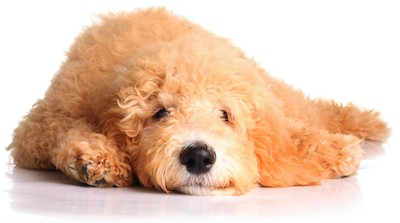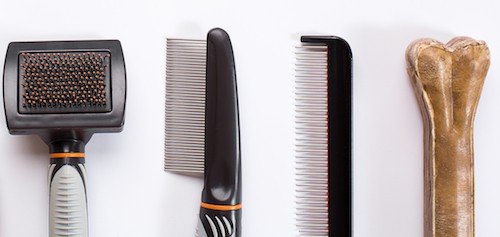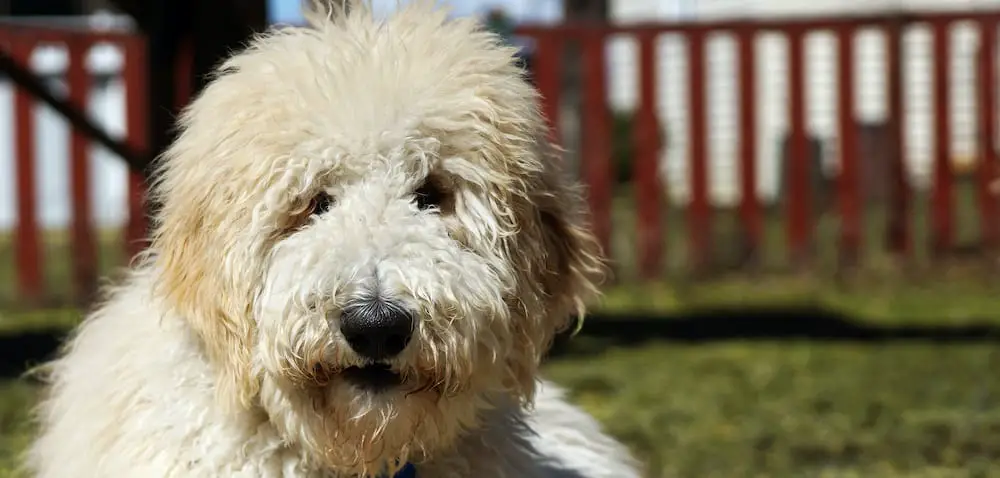April 14, 2021
Goldendoodles are loved in the dog world thanks to their great personalities, cute appearance, and their "hypoallergenic" coats. When somebody says that, they usually are referring to the dog's tendency to shed, not their ability to prevent somebody who is allergic from having a reaction.
Although this breed is this not actually hypoallergenic, as no dog breed is, it is considered one because it is less likely to cause an allergic reaction when compared to many other breeds. This, however, does not mean Goldendoodles don't shed.
In fact, they do shed, and the factors behind their shedding are quite interesting.

Factors That Can Affect Your Goldendoodle’s Shedding
Seasons
The sunlight and the temperature outside play a role in how much your dog sheds. In winter, we experience less sunlight. The temperatures drop low. This, in turn, causes your Goldendoodle to begin growing a new coat, whilst getting rid of the old one to accommodate these new environmental changes.
Meanwhile, in summer, the days are longer, and the temps are warmer. As a result, the Goldendoodle sheds the winter coat, making room for a coat that feels better in warm temperatures.
Like most breeds, the Goldendoodle sheds twice a year as a means of adapting to these seasonal changes. If you have a Goldendoodle that lives mostly indoors, where the temperature remains constant, and natural light is limited, you may find that your dog sheds continuously instead of bi-annually.
Type of Coat
A Goldendoodle is a double coat dog. This means that the dog has a soft, short, but also a quite dense undercoat. They also have a top coat, which is more or less a protective outer layer for the undercoat. This topcoat is the one we see visibly- it is longer and rougher than the undercoat as its main job is to protect the skin and undercoat of your dog.
A common misconception among dog lovers is that short hair variants shed less than long-haired ones – this is not true.
To see the undercoat, gently pull back the hair of your dog and see how the coat follows to the skin. Look closely, as the undercoat can be quite dense and close to the skin! Double coat dogs shed hugely twice per year; as we mentioned, this mostly takes place during the arrival of the spring and winter seasons.
And one other side note we'd like to mention: do not let coat length determine the type of Goldendoodle you should adopt. A common misconception among dog lovers is that short hair variants shed less than long-haired ones – this is not true.
However, having a short-haired dog will make it easier to groom the animal, as the fur is less apt to become tangled or knotted.

Losing the Puppy Hair
A puppy is born with a soft coat of fur. It helps keep the body temperature regulated and protects the animal from environmental hazards. The puppy fur is usually shorter than the adult fur, and you will notice as your pup grows, his fur begins to feel thick and rough in nature.
The appearance of the fur changes thanks to the arrival of the adult fur. Shedding of the puppy coat can happen when the animal reaches three months old. However, it will vary from dog to dog.
You will notice your pet looking a little shaggy as this process takes place, and there is no reason to be concerned. Other things you may notice include changes in fur color or its pattern. These are all part of your dog going from being a puppy to an adult.
Age
We have already talked about how puppies lose their puppy hair, and that adult dogs shed regularly. But what about senior or older dogs? In most cases, hair loss in senior Goldendoodles isn't something to worry about.
However, some dogs can develop a thin coat known as hypotrichosis or alopecia. The best thing to do if you suspect a difference in coat thickness is to ask your groomer what they think.
These individuals deal directly with dog hair and will be able to help you understand why your dog's hair is the way it is. Then, you can make an appointment with the vet if needed to get the dog on a treatment path.
Nutrition
What your Goldendoodle eats plays a role in their coat and skin health. A dog with healthy skin has healthy hair follicles which give the pet his beautiful and shiny coat. Meanwhile, unhealthy skin usually comes with lacking skin oils and, in turn, dull, brittle hair.
If a dog is not getting the right amount of nutrients and calories, hair can end up looking worse for the wear, and may even fall out.
Opt for quality dog foods that are loaded with nutrients, and for hair health, look for a healthy amount of protein, Omega 3 and 6 fatty acids, and whole grains, which give the dog carbohydrates. The combination of all these nutrients will give the dog what he needs to have a healthy coat.
Health
If a dog has an allergy, they may scratch excessively and thus pull their hair out. As a result, these dogs look like they shed more than dogs who do not have allergies. Having fleas, for example, can lead a dog to scratch intensely.
The cleanliness of the skin also plays a role in how your dog sheds. Hair that is dirty or matted lets bacteria grow faster and may infect the hair follicles, which leads to hair loss.
Baths
Bathing your dog excessively can lead to shedding that is frequent and more pronounced. If your dog is dirty, then, by all means, bathe him. However, bathing is not required for dogs more than once a month, if that.
Bathing a dog too much can lead him to have dandruff, as well as the increased loss of hair. The oils of your dog's coat are washed away when he is bathed, leading to more shedding.
On the other hand, bathing once a month with proper dog shampoo (don't use your own shampoo on your dog) will loosen dead hair and help you control shedding when combined with regular brushing.
Hormonal Cycles
Thyroid hormones stimulate follicles, which enables them to spend more time growing hair and less time resting.
This is why dogs dealing with hypothyroidism have coats that are dry and thin, and thus lack thyroxin as a means of activating the follicles. Other hormones that affect the dog's coat include testosterone, progesterone, cortisol, and growth hormone.
How to Reduce a Goldendoodle’s Shedding?
7 Actionable Tips
1. Brushing
A good bristle brush will help you keep your Goldendoodle's coat under control and looking great.
- If you have a doodle with a longer coat, look for a bristle brush that has wider spaced and longer bristles.
- If the doodle has particularly coarse hair, opt for a brush with stiff bristles.
Brush your doodle a few times a week - some of you may need to brush every day depending on your individual dog.
2. Deshedding
A great shedding tool will also help keep your pup looking good and minimize the fur you see. Opt for a de-shedding tool that is designed just for the removal of dead hair from your dog's coat. It will help you see a reduction in the amount of "tumbleweeds" you see, floating around your residence.

3. Bathing
Regular baths are a great way to reduce shedding. You can use a good de-shedding shampoo- these are made with moisturizers and nutrients that will hydrate the skin of your dog and, in turn, promote healthier hair follicles.
A regular monthly bath plus de-shedding and brushing help you minimize shedding
These shampoos also help loosen up and remove the excess undercoat. A regular monthly bath plus de-shedding and brushing help you minimize shedding.
4. Grooming
You can take your dog to the groomer, or groom your dog at home. Goldendoodles must use an undercoat rake- this tool pulls out the loose undercoat.
You should keep gently pulling it through until it goes through the hair easily. If your dog has mats in his fur, you can use a de-matting rake to untangle the mats.
5. Healthy Nutrition
Dogs that get fed a healthy and balanced diet will have all the vitamins, minerals, and nutrients needed to live a healthy life. Their hair will resist breakage and grow to a soft, glossy coat. Make sure your dog's food gives him adequate Omega-3 fatty acids- and if not, check with your vet about a good Omega-3 supplement you can give to your dog to support his hair growth.
6. Clean Water
Make sure clean, fresh water is always available. A good rule of thumb is that the dog should drink one ounce per pound of their weight. Having a dehydrated dog is one surefire way to see lots of loose hair floating around.
7. Prevent and Treat Skin Diseases
Make sure regular vet visits are part of your agenda. Alopecia, skin allergies, infections, or parasites can all plague your pooch and cause him to lose hair, whether it is by scratching or because hair follicles are no longer healthy.
If your dog is showing excessive hair loss or patches of hair are falling out, get him to the vet right away.


